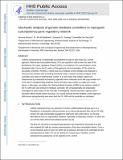Stochastic analysis of genetic feedback controllers to reprogram a pluripotency gene regulatory network
Author(s)
Bruno, Simone; Al-Radhawi, M. Ali; Sontag, Eduardo D.; Del Vecchio, Domitilla
DownloadAccepted version (1.257Mb)
Open Access Policy
Open Access Policy
Creative Commons Attribution-Noncommercial-Share Alike
Terms of use
Metadata
Show full item recordAbstract
© 2019 American Automatic Control Council. Cellular reprogramming is traditionally accomplished through an open loop (OL) control approach, wherein key transcription factors (TFs) are injected in cells to steer the state of the pluripotency (PL) gene regulatory network (GRN), as encoded by TFs concentrations, to the pluripotent state. Due to the OL nature of this approach, the concentration of TFs cannot be accurately controlled. Recently, a closed loop (CL) feedback control strategy was proposed to overcome this problem with promising theoretical results. However, previous analyses of the controller were based on deterministic models. It is well known that cellular systems are characterized by substantial stochasticity, especially when molecules are in low copy number as it is the case in reprogramming problems wherein the gene copy number is usually one or two. Hence, in this paper, we analyze the Chemical Master Equation (CME) for the reaction model of the PL GRN with and without the feedback controller. We computationally and analytically investigate the performance of the controller in biologically relevant parameter regimes where stochastic effects dictate system dynamics. Our results indicate that the feedback control approach still ensures reprogramming even when both the PL GRN and the controller are stochastic.
Date issued
2019-07Department
Massachusetts Institute of Technology. Department of Mechanical EngineeringJournal
Proceedings of the American Control Conference
Publisher
IEEE
Citation
Bruno, Simone, Al-Radhawi, M. Ali, Sontag, Eduardo D. and Del Vecchio, Domitilla. 2019. "Stochastic analysis of genetic feedback controllers to reprogram a pluripotency gene regulatory network." Proceedings of the American Control Conference, 2019-July.
Version: Author's final manuscript